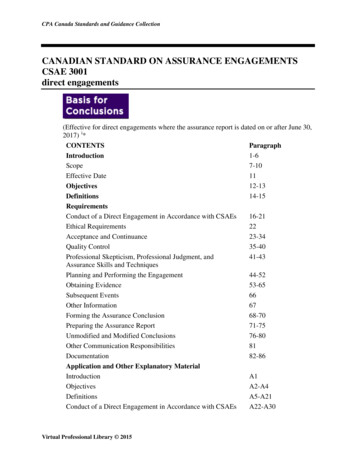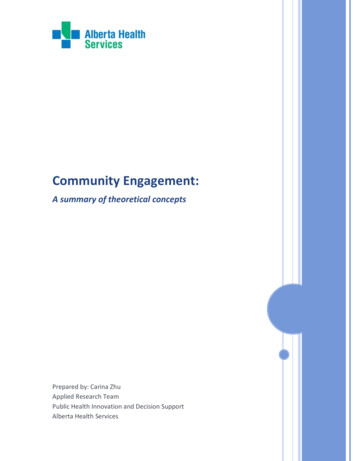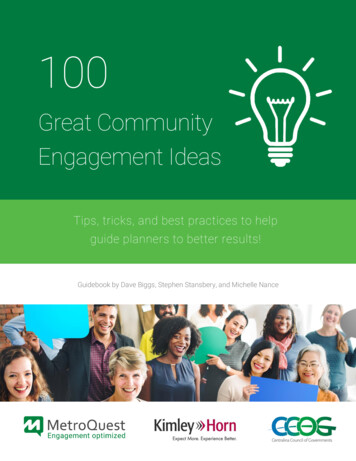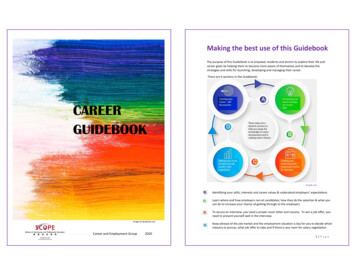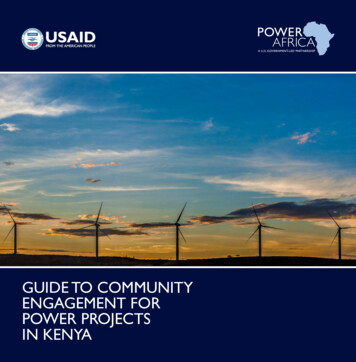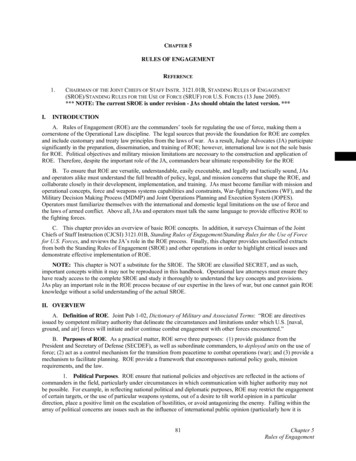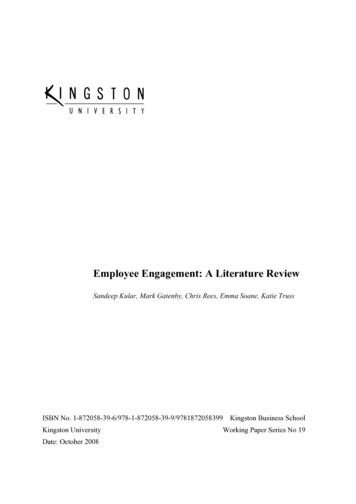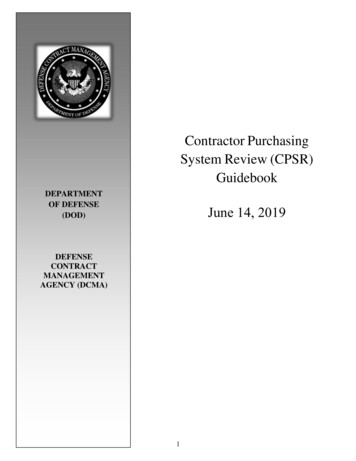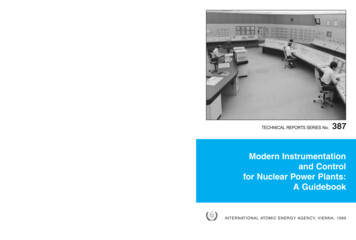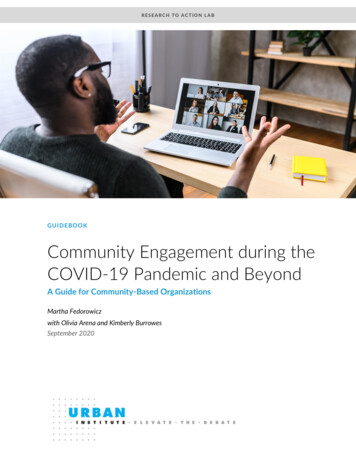
Transcription
RESEARCH TO ACTION LABGUI DEBOOKCommunity Engagement during theCOVID-19 Pandemic and BeyondA Guide for Community-Based OrganizationsMartha Fedorowiczwith Olivia Arena and Kimberly BurrowesSeptember 2020
ABO UT THE U RB AN INS TI TU TEThe nonprofit Urban Institute is a leading research organization dedicated to developing evidence-based insightsthat improve people’s lives and strengthen communities. For 50 years, Urban has been the trusted source forrigorous analysis of complex social and economic issues; strategic advice to policymakers, philanthropists, andpractitioners; and new, promising ideas that expand opportunities for all. Our work inspires effective decisionsthat advance fairness and enhance the well-being of people and places.Copyright September 2020. Urban Institute. Permission is granted for reproduction of this file, with attribution tothe Urban Institute. Cover image by Vadym Pastukh/Shutterstock.
ContentsAcknowledgmentsivCommunity Engagement during the COVID-19 Pandemic and Beyond1What Is Community Engagement?2Is Now the Right Time for Community Engagement?4Tools for Engagement5Nondigital Tools for Community Engagement during the COVID-19 Pandemic and Beyond5Digital Tools for Community Engagement6Best Practices for All Community Engagement11Sample Engagement Methods14Example 1: Crowdsourcing14Example 2: Ecosystem Mapping15Example 3: Data Walks17Conclusion20Worksheet 1: Assess the Community’s Readiness for Community Engagement21Worksheet 2: Draft Your Logic Model23Worksheet 3: Complete the Strategy Triage Tool24Worksheet 4: Plan for Your Community Engagement25Appendix: Additional Community Engagement Resources28Notes29References30About the Author31Statement of Independence32
AcknowledgmentsThis report was funded by the John D. and Catherine T. MacArthur Foundation. We are grateful tothem and to all our funders, who make it possible for Urban to advance its mission.The views expressed are those of the author and should not be attributed to the Urban Institute,its trustees, or its funders. Funders do not determine research findings or the insights andrecommendations of Urban experts. Further information on the Urban Institute’s funding principles isavailable at urban.org/fundingprinciples.We are especially grateful to Elsa Falkenburger for her expert content review and guidance. Weare also grateful to the Garfield Park Wellness Collaborative who inspired the creation of this guide.ivACKNOWLEDGMENTS
Community Engagement during theCOVID-19 Pandemic and BeyondThis guide is meant to assist community-based organizations that are interested in facilitating remotecommunity engagement activities. Although this guide was developed as a response to the COVID-19pandemic, it can also be used by organizations looking to broaden their outreach strategy generally.In this guide, we present a list of tools that can be used for facilitating remote communityengagement activities and aim to elevate some best practices for any form of in-person or remotecommunity engagement. This brief consists of the following sections: What Is Community Engagement? Is Now the Right Time for Community Engagement? Tools for Engagement»Nondigital Tools»Digital Tools Best Practices for All Community Engagement Sample Engagement MethodsIn the appendices, we provide a few worksheets to help you plan your community engagementactivities and a list of supplemental resources on inclusive community engagement methods.
What Is Community Engagement?Community engagement is a process by which community members come together to reflect on andmake decisions about the future of their community. The term “community engagement” often refersto a specific process facilitated by local governments or community-based organizations when theyhave an impending action or necessary step. For example, they may use community engagementprocesses to plan how to use vacant space in a community, to respond to a proposed development, orto develop a response to a public health or environmental challenge. Community engagement can takeplace in person or online, and it can be an isolated, one-time event, or it can be an ongoingengagement.Over the past decade, policymakers and practitioners have increasingly focused on the need tomeaningfully engage people who have long been left out of community engagement activities. Groupsoften excluded include the elderly, citizens reentering public life after incarceration, people withlimited access to the internet or with limited computer literacy, immigrants, homeless people, peoplewith physical and mental disabilities, people with low incomes, people working several jobs or workingduring nontraditional hours, and people who are English-language learners. Moreover, rising levels ofracial inequality and income inequality is a contributing factor to unequal access to public power(Holley 2016).Community-based organizations have also recognized that community engagement must begin bybuilding personal relationships among community members before those organizations can beencouraged to interact with neighborhood, community, and civic institutions.1 As Kip Holley (2016)writes in the Principles for Equitable and Inclusive Engagement, “intentionally using the communityengagement environment to build bridging social capital—social capital that is built among diversecommunity members—has been shown to help create new connections between diverse communitymembers and make resources available within the community, encouraging community member tobecome involved in the lives of their neighbors. These connections reflect strong attachments tocommunities and a commitment to making them better places for everyone.”Some common forms of community engagement include town halls, participatory budgeting,community mapping, community action planning, charrettes, crowdsourcing, surveys, community-basedparticipatory research, and focus groups. Although we will not delve deeply into all of these methods inthis guide, we will describe a few of them. You can also read more about these and other methods in theTamarack Institute’s Index of Community Engagement Techniques. All of these methods exist on aspectrum (Arnstein 1969). On one side of the spectrum are activities that “inform” the public about a2COMMUNITY ENGAGEMENT DURING THE COVID -19 PANDEMIC AND BEYOND
specific topic or event; on the other side are activities that “empower” community members by puttingthem in leadership roles. Table 1 presents the spectrum of community engagement, describes how toframe the goals of each level of engagement to community members, and offers some sampleengagement techniques that fit under each level.TABLE 1Spectrum of Community EngagementPublicparticipationgoalPromise tothe rateEmpowerTo provide thepublic with balancedand objectiveinformation to helpthem understandthe problem,alternatives,opportunities,and/or solutionsWe will keep youinformedTo obtain publicfeedback onanalysis,alternatives,and/ordecisionsTo work directlywith the publicthroughout theprocess to ensurepublic concernsand aspirations areconsistentlyunderstood andconsideredWe will work withyou to ensure thatyour concerns andaspirations aredirectly reflectedin the alternativesdeveloped andprovide feedbackon how publicinput influencedthe decisionTo partner withthe public in eachaspect of thedecision, includingdevelopingalternatives andidentifying thepreferred solutionTo place finaldecisions inthe hands ofthe publicWe will look toyou for directadvice andinnovation informulatingsolutions andincorporate youradvice andrecommendationsinto the decisionto the maximumextent possible Citizen advisorycommittees Consensusbuilding ParticipatorydecisionmakingWe willimplementwhat youdecide Fact sheetsWebsitesOpen housesWe will keepyou informed,listen to andacknowledgeconcerns andaspirations, andprovidefeedback onhow publicinput influencedthat decision PubliccommentFocus groupsSurveysPublicmeetings WorkshopsDeliberativepolling CitizenjuriesBallotsDelegateddecisionsSource: IAP Spectrum of Public Participation, found at “The Three Pillars of Public Participation,” International Association forPublic Participation, accessed August 5, 2020, https://www.iap2.org/page/pillars.COMMUNITY ENGAGEMENT DURING THE COVID -19 PANDEMIC AND BEYOND3
Is Now the Right Time for Community Engagement?Community-based organizations can engage community members in many ways during the COVID-19pandemic, so before beginning outreach, ask yourself the following questions (a worksheet with thesequestions can be found at the end of the guide):1. What are we hoping to achieve through community engagement? When we receive thatinput, will we be able to act on it?2. Is it critical that we collect this input right now? Could some input gathering be postponed oneweek? One month? Several months? How will postponing engagements affect the long-termproject goals?3. Do the engagements we want to host and the questions we want to ask reflect the currentsituation? How can we adapt our questions to acknowledge what is going on and offer spacefor community members to talk about how they’re doing during this pandemic?4. Will anyone respond to our questions right now?5. Can we engage a representative sample of our community, or would we miss some people ifwe proceeded with engagement right now?6. How will community members receive our request (i.e., will they be accommodating,frustrated, or bothered)?7. Do we have mechanisms in place to avoid overburdening our community members withrequests for input? (Answering this question will require an awareness of what other outreachcommunity groups are doing and of what resources and budget are available.)8. Are there other things we can be doing now to advance our goals or support communitymembers that don’t involve hosting community engagement events or conducting surveys? Ifso, are these options we can easily implement and that fit within our budget and capabilities?Answering these questions can provide some insight into whether now is most appropriate forlaunching a community engagement strategy. How the public health and economic crisis is affectingdifferent community members is unclear, but understanding that effect is critical for building trust andempowering residents. If community members sense that you are ignoring their current situation ornot being responsive to more immediate needs, you risk losing the community’s trust and damagingrelationships that will be critical to future work.Many project-planning approaches are available to help determine how community engagementapproaches fit into larger project goals. These include developing a logic model for an engagement orreassessing the team’s original strategy given a crisis or major roadblock. For example, Marian Urquillaof StrategyLift developed a Strategy Triage Tool that can help organizations determine what they canand should do now and what should be delayed until people can gather safely.2 Worksheets to helpyour organization go through these planning steps can be found at the end of this guide.4COMMUNITY ENGAGEMENT DURING THE COVID -19 PANDEMIC AND BEYOND
Tools for EngagementNondigital Tools for Community Engagement during the COVID-19 Pandemicand BeyondWhen beginning to scope a community engagement strategy, consider the audience and their accessto participation in a feedback model. These considerations include assessing which channels can bestreach different community members and who some of the trusted sources might be for sharing thisinformation. Even now as many people practice social distancing, opportunities can arise to connectwith people with limited mobility, internet access, limited familiarity with computers and the internet,or time. In this section, we share some nondigital tools for engaging with groups who are oftenexcluded from community engagement activities.In addition to considering some of the engagement methods below, community-basedorganizations should also consider how to augment their outreach to better engage people withdifferent levels of language ability and access. Groups who are often excluded from digital forms ofengagement include the elderly, citizens reentering public life after incarceration, immigrants, thehomeless, people with physical and mental disabilities, people with low incomes, people workingseveral jobs or working nontraditional hours, and people who are English-language learners. TheCOVID-19 pandemic may have expanded that list to include people who have had to take onadditional child care, work, or schooling responsibilities to support their family and people who havelost their jobs, become food insecure, or become housing instable. These groups should not be left outof engagement efforts, so it will be critical to consider the new circumstances that your communitymembers find themselves in before launching an engagement and to meet people where they aregiven present circumstances.If you decide to proceed with nondigital engagement methods, you might consider some of thefollowing: Making phone calls and phone trees can be a great way to engage with the elderly, peoplewho don’t have access to the internet, or people without the computer literacy skills tonavigate social media. A phone tree is a planned system for reaching out to members in yourcommunity that designates key callers who contact specific people under their “branch” of thetree. These people will then reach out to more people under their own branches. For moreinformation on how to set up a phone tree, consult “How to Build a Phone Tree” from theAmerican Association of University Women.3 If your community has a nursing home, youCOMMUNITY ENGAGEMENT DURING THE COVID -19 PANDEMIC AND BEYOND5
might consider soliciting the support of staff there to distribute flyers about the project with anumber to call if residents want to share thoughts on the project. Mailing information to people’s homes is still an effective way to reach many groups. Mailersare often used to share information, but they may also include a survey for people to respondto a few questions. With this strategy, including a postage-paid envelope will encourageparticipation and reduce any disparities in response caused by income. This approach mayhave a lower response rate than online survey mechanisms, but it could lead to rich feedbackfrom those that fill out a survey. If only used to share information, this method could reachgroups who may not receive the information through phone or online engagement or whomay feel uncomfortable sharing information digitally. To connect mailed-in responses withthose submitted online, a staff member from the community-based organization shouldmanually input mailed-in surveys into whatever digital survey response tool the team is usingso that all responses can be found in one place. Using community networks and connections to distribute newsletters or deliver a survey.Think about ways to engage with these groups through other people they know. For example,could you get someone’s grandchild to call their grandparents and conduct a survey? Couldyou use the head of a realtor’s group to connect with realtors in their network? Couldreligious organizations or other community-based networks share project information throughtheir channels? By capitalizing on existing community networks and connections, you may beable to gather more honest, in-depth responses and gather a greater number of responses.Plus, utilizing community champions (who people already feel comfortable talking to) will helpbuild trust in the community. Utilizing gatherings that are happening in person (i.e., mutual-aid services and materials,technology pickups from schools, etc.) to meet people where they are. Although most inperson events have been canceled during the pandemic, many activities are still operating toensure that people have access to the resources and supports they need. By partnering withanother community-based organization that is distributing food or school supplies, or byoperating a food drive yourself, you can use these brief moments of human interactionstrategically to share information, ask questions, and brainstorm about how policies orprograms could be improved.4Digital Tools for Community EngagementSeveral online platforms are available for engaging community members. Considering your targetaudience and the key messages you want to deliver can help you to determine the most appropriatetool to use. This section presents some available online platforms and how they can be best used forcommunity engagement.6COMMUNITY ENGAGEMENT DURING THE COVID -19 PANDEMIC AND BEYOND
SOCIAL MEDIA, SUCH AS FACEBOOK, INSTAGRAM, LINKEDIN, AND TIK TOKGoal: Inform and consultNotes about use: Social media platforms can offer a quick way to informally engage with communitymembers. The users of each platform vary, and you will need to strategize how best to use each.These platforms are often popular with young people, though Facebook is used by many BabyBoomers (people born between 1944 and 1964).Social media offers the ability to share bite-sized information and can increase awareness orgarner support for a single issue. Having strong visuals is key Sharing lengthy information, engaging onmultiple topics, or conducting activities that require a feedback loop can be challenging tasks on socialmedia. But these platforms can be used to build trust through regular contact or keep ongoingattention on a topic.Facebook and LinkedIn also have event pages where users can advertise for a specific event.Potential challenges to consider: One potential challenge for using social media platforms is thatanyone can post anything. Thus, it is critical you have an active moderator on the platforms whoapproves content and who can monitor posts to address challenging comments as soon as they areposted.Because of these challenges, social media platforms require more attention, engagement, andmonitoring from you than other tools listed here.Pricing: Using social media tools is free, but depending on your goals for each platform, you might alsoconsider purchasing ads to gain new users or promote a project or event.WEBINAR AND MEETING SOFTWARE, SUCH AS ZOOM, GOTOMEETING, GOOGLE HANGOUTS,LOOM, AND WEBEXGoal: Inform, consult, and involveNotes about use: Webinar software can be great tools to engage community members in deeperconversations, and they can help build and maintain connections while people are social distancing.Moreover, they do not all require internet access: many, such as Zoom and GoToMeeting, can beaccessed by phone, which makes them more accessible to those without reliable internet service.Meetings can also be recorded, which helps preserve records of discussions.COMMUNITY ENGAGEMENT DURING THE COVID -19 PANDEMIC AND BEYOND7
These platforms offer the ability to host discussions, focus groups, and webinars on differenttopics, and they can be great tools for gathering ideas and feedback on a proposed plan. Facilitatorscan share their screen to show slides or visuals to attendees (but be aware that folks who call in usingonly a phone will not be able to see them). Although these platforms are often used to conductmeetings and host webinars, they can be fun and engaging ways to connect with people if used forcreative activities and icebreakers.Potential challenges to consider: Recent instances of “Zoom bombing” highlight the privacy andsecurity precautions necessary to protect people on the call. Each platform has different ways tomonitor who can join a call, so be sure to spend some time investigating how this works.Further, if you plan to record a meeting, it is important to inform attendees of this, especially ifyou plan to publish the recording .Pricing: Loom and Google Hangouts are both free with an account. Zoom, WebEx, and GoToMeetinghave pricing plans for different levels of use.ONLINE BRAINSTORMING TOOLS, SUCH AS MURAL, GOOGLE DOCS, BOX NOTEGoal: Involve and collaborateNotes about use: Online brainstorming and idea aggregation tools such as Mural, Google Docs, andBox Note can be great options to engage a group of people to work simultaneously in one document.Although you can invite anyone to work on these platforms, they might be best used with a smalleradvisory group during the planning phase of a project so documents do not become too complicated.Potential challenges to consider: Because anyone with a login and link to a document can contributeto it, establish guidelines for contributing so that everyone has a chance to contribute and thedocuments don’t become unruly. Because many of these tools allow users to create different versionsof documents, make someone responsible for keeping folders clean and organized and trackingdocument versions to make sure everyone is working on the most recent document.Pricing: Google Docs is free with a Google account; the other two platforms are low cost.8COMMUNITY ENGAGEMENT DURING THE COVID -19 PANDEMIC AND BEYOND
COLLABORATIVE PROJECT PLANNING TOOLS, SUCH AS SHAPE, MIRO, WHIMSICAL, IDEAFLIPGoal: CollaborateNotes about use: If you want to improve your project planning, consider using a collaborative projectplanning site like the ones listed here. All of these platforms allow users to create visual brainstormingspaces and organize ideas for strategic planning.Some include tools such as flowcharts, mind maps, workflow organizers, and surveys. Becausemany of these tools are quite advanced, they are best used by the main project team or by an advisorycommittee.Potential challenges to consider: Because these tools are less used than and not as well-known asothers listed previously, implementing them on a team may require some training so that communitymembers feel comfortable with their use. Especially for people who are less adept with newtechnology, users may need some time to feel comfortable with them. Hosting trainings on their usewill be important to include in project planning timelines.Pricing: Miro is free; Shape, IdeaFlip, and Whimsical have different pricing plans depending on thenumber of users.SURVEY PLATFORMS SUCH AS QUALTRICS, SURVEY MONKEY, GOOGLE FORMSGoal: ConsultNotes about use: Surveys are a great way to gather information about community members and theirneeds or gather feedback on proposed plans and ideas. They can also be used to generate ideas, butthey generally work best when both the questions and response choices (if not open-ended) are clearand direct.Surveys can ask several types of question, including fill in the blank, multiple choice, tick boxes(where people can select more than one option), rankings, and open-ended questions. You can alsoinsert pictures or documents that you want respondents to review and respond to. Depending on yourpurpose for distributing the survey, you should think carefully about which question types to use andhow many questions to send.Most surveys are fairly easy to complete, especially if users have a basic level of computer literacyand experience using the internet. As shared in the nondigital tools section, if you decide to deliver asurvey on paper or over the phone, we recommend that you enter the responses into any onlinesurvey you also fielded so that all of the responses are in one place.COMMUNITY ENGAGEMENT DURING THE COVID -19 PANDEMIC AND BEYOND9
Also, many survey platforms have basic data analysis capabilities, which can be very helpful forunderstanding responses in aggregate. For example, the analysis could tell you what percentage ofrespondents answered a certain way on a multiple-choice question. Of course, it cannot analyzeresponses to open-ended questions, so keep that limitation in mind when deciding what type ofquestions to ask.Potential challenges to consider: Survey design, especially for data collection, is a true science. Beforefielding a survey, it might be helpful to offer a basic training on survey design or to consult bestpractices. For example, surveys are best with fewer questions (which encourages higher responserates), with questions that aren’t leading, and with a disclaimer about how the data are being used.Be careful not to extrapolate beyond what the data are telling you. For example, if only 20 peoplecomplete your survey, it might not be fair to say these responses are representative of your community.Any presentation of the survey data should clearly state how many people completed the survey andtry to delineate the demographics of those who answered.Pricing: Qualtrics requires a paid account. Survey Monkey can be used for free with limitedfunctionality; paying for an account allows for more options and data analysis. Google Forms is free touse with a Google account.10COMMUNITY ENGAGEMENT DURING THE COVID -19 PANDEMIC AND BEYOND
Best Practices for All Community EngagementNow that we’ve shared examples of nondigital and digital tools for engagement and discussed some ofthe ways they can be used, we also offer some best practices and tips for any form of engagement.Worksheet 4 at the end of this guide can help you to apply these practices to planning a communityengagement activity.1. Manage your team’s engagement expectations.Communities are faring unpredictably during the pandemic, so people may have varyingabilities to participate in both nondigital and digital engagements. Organizations seeking toengage communities right now may need to reflect on what they are able to accomplish withalready-available or internal information and on what can and cannot be advanced withreasonable community input. Be clear about what equity challenges were already presentand/or are exacerbated by the pandemic, and consider what groups may or may not be a partof the conversation right now and how to mitigate any exclusion. Going through the questionsfrom the “Is Now the Right Time for Community Engagement?” section (which are alsoavailable in Worksheet 1) is a great way to begin to understand and manage your expectations.2. Understand the capacities and benefits of various platforms and tools.Some engagements can be short and quick; others should be longer, more sustainedengagements that build over time. Using polling features on social media and webinar softwareor sending out a short survey can be good ways to get a small amount of feedback quickly. OnFacebook, for example, when someone requests to join a group you administrate, you can askthem up to three questions as part of that request. Similarly, Zoom has a polling function thatcan be used to poll meeting attendees. This can be a good way to quickly gather some data. Ifyou don’t use Facebook or Zoom, check whether your platform has a polling function you canuse to collect some initial data about people who come to the site or meeting.If you plan for when and how often to use these functions, you can use several smallerengagements to build one larger idea-generating activity. You can also combine many smallengagements with various groups of people to get a more representative picture of what thecommunity wants. For example, you could send out an electronic survey using a platform suchas Survey Monkey to audiences likely to engage online and use physical mail to send papersurveys to those with limited or no access to computers or the internet. Once you receive thepaper surveys back, you can manually enter the data into Survey Monkey so all the responsesare stored in one place. If you have a project website, videos can also be a useful way toremind participants that there are real people behind the work and to introduce them todifferent members of the team. Consider posting a weekly video update on where the projectis. This lets community members know that the project is moving forward even if they can’tsee the physical impacts of the work being done.3. Remember that users have various levels of familiarity and comfort with different platforms,and build in time for training and practice.Several of the tools suggested previously may be new for some community members. Thisdoesn’t mean that they absolutely should not be used; rather, you may need to build in time toprovide lessons on how to use them and to give people time to practice using them before theactual engagement exercise begins. Many digital platforms offer tutorial videos to help newusers, or you could develop a training of your own that is more tailored to how you want touse a specific tool.COMMUNITY ENGAGEMENT DURING THE COVID -19 PANDEMIC AND BEYOND11
4. Consider compensating community members for their participation, and plan for this in yourbudget.Participating in community engagement activities takes time and energy. Paying people toparticipate shows that you value their time and ideas and understand that they may haveother needs that must be met. In-person community engagement activities often provideaccommodations such as transportation passes, child care, and meals. Although you won’tneed to offer these things for remote engagements, you might consider thanking people fortheir time by offering gift cards or cash compensation for people who take surveys or payingpeople a full hourly wage if they participate in more in-depth engagements such as webinars,focus groups, or online project-planning exercises.5. Think about timing.Conducting calls, facilitating project planning exercises, or hosting webinars during thedaytime reach some populations well, especially because some people are not working orhave flexible hours. But others may have taken on additional caretaking or schoolingresponsibilities or have jobs with evening and weekend hours. More-flexible engagementmethods that can be completed whenever a community member has time (such as mailed oronline surveys) might be better to reach these groups.6. Make a good first impression.Starting your project off on the right foot is key if you want to have a successful engagement.You should plan to start with a clea
racial inequality and income inequality is a contributing factor to unequal access to public power (Holley 2016). Community-based organizations have also recognized that community engagement must begin by building personal relationships

